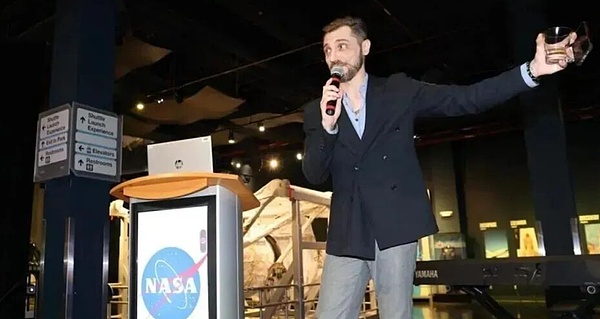The TON Blockchain, through on-chain voting to select civilian astronauts for Blue Origin flights, has pioneered "space democracy," enabling global public participation in space travel. From Bitcoin's first space transaction to tokenized lunar domain names, blockchain is driving a new decentralized space race, democratizing access and ownership. As a child, I wanted to be an astronaut. I dreamed of floating in zero gravity, watching the Earth spin beneath me, and maybe one day walking on the moon. While I never went into space, my life came full circle while working at AWS, when a partner and I helped land a rover on Mars. That experience made me realize there are many ways to explore new frontiers, and today, one of the most exciting ways isn't through rockets, but through code. Blockchain, the technology that began with digital currency, is now expanding into orbit. Space has always captured the human imagination. For decades, it has been the exclusive domain of governments, billionaires, and aerospace giants. Today, a quiet revolution is bringing blockchain into everyone's daily lives. Blockchain is moving beyond finance and into orbit, laying the foundation for a decentralized space economy. What is decentralized space? Decentralized space is the fusion of blockchain and space exploration. It leverages smart contracts, tokenization, and decentralized governance to enable anyone with a digital wallet to participate in the space economy. Rather than relying on a few large institutions, decentralized space allows communities, creators, and investors to co-own and co-govern assets like satellites, payloads, and even lunar missions. It brings transparency and inclusivity to what has long been a domain of exclusive ownership, creating an open network that extends access and ownership beyond Earth. It combines space technology with the transparency, inclusivity, and verifiable ownership principles of Web3 to create an open network that allows anyone to contribute to humanity's journey beyond Earth. According to PricewaterhouseCoopers (PWC), space will become the first new trillion-dollar asset class of the 21st century and the first asset class to exist natively on-chain. Why is decentralized space relevant to Bitcoin? The origins of decentralized space can be traced back to Bitcoin. In 2019, SpaceChain's blockchain node launched into orbit aboard a SpaceX Falcon 9 rocket. The node enabled multi-signature Bitcoin transactions from space, marking the first time blockchain and Bitcoin transactions were conducted in orbit. Bitcoin recently reached an all-time high and then fell back, just like a rocket! This milestone demonstrated that blockchain can operate beyond Earth and is independent of terrestrial infrastructure. It has inspired a number of projects exploring how digital assets and decentralized systems can support future space missions. What began with Bitcoin has expanded into an entire ecosystem where tokens, domain names, and smart contracts connect people to space in unprecedented ways. Three pioneering projects are leading this transformation: SpaceCoin is creating a blockchain infrastructure to operate via satellites. Copernic Space is tokenizing space assets and digital domain names associated with lunar missions. The Open Network (TON), the blockchain behind Telegram, enables on-chain voting for real astronaut seats on Blue Origin flights. Together, they demonstrate how the future of space can be shared by more people. SpaceCoin and DePIN in Orbit: More Than Just Bitcoin SpaceCoin's vision is simple yet radical. It aims to create a network of satellites that transmit blockchain transactions directly through space, without relying on Earth's internet. In a recent test, SpaceCoin successfully transmitted data across continents using only satellite links. This data wasn't just a signal; it was a blockchain record transmitted across orbit. This concept belongs to a new category called Decentralized Physical Infrastructure Networks (DePINs). These projects use blockchain to power real-world infrastructure, rather than purely digital systems. SpaceCoin's network can serve remote locations, censored areas, and space-based devices that need secure communications without relying on terrestrial internet. SpaceCoin Demonstrates How DePIN Works in Space at Token 2049 - Sandy Carter The implications are enormous. At Token 2049, I chatted with SpaceCoin founder and CEO Taekyung Oh, who told me, "Space is the ultimate decentralized frontier. With DePIN, we're turning satellites into nodes in a global network where connectivity, computation, and coordination transcend national borders and even beyond Earth." If blockchains can operate in orbit, transaction, identity, and governance systems will no longer be constrained by Earth. Space-based blockchains can enable global connectivity, resist censorship or natural disasters, and prepare for the era of interstellar communication. While numerous challenges remain, such as satellite costs, regulatory issues, and reliability, the concept of blockchain truly reaching for the stars is no longer science fiction. If SpaceCoin provides the infrastructure, then Copernic Space provides the ownership and financial infrastructure to power this new economy. The company uses blockchain technology to connect real-world space assets with global capital markets, pioneering the tokenization of missions, payloads, and even digital identities, transforming how space assets are represented, financed, and traded. Did you know? Copernic Space has partnered with SpaceChain to build a commercial marketplace for tokenized space assets. This collaboration builds on SpaceChain's earlier work demonstrating that blockchain technology, such as Bitcoin, can operate beyond Earth. Recently, Copernic Space partnered with Unstoppable Domains (my employer) to launch the .LUNAR domain extension, the first domain tied to a real-world space mission. Each .LUNAR badge will be sent to the moon on a mission scheduled for 2026-2027. This makes each domain a tokenized, real-world asset tied to space. Owning a domain means holding a verified digital identity that will actually travel beyond Earth. Copernic Space has demonstrated how this model works in practice. Its commercialized rocket and its first lunar mission earlier this year sold out, with over 2,000 tokenized payloads, including landings of individuals and companies on the Moon, generating revenue and rewards for early adopters.
In a conversation with Grant Blaisdell, CEO of Copernic Space, he told me: "Decentralization gives space back to humanity. For the first time, people around the world can own a small but meaningful share in the space enterprise. By combining blockchain with space missions and projects, we are creating a transparent, participatory ecosystem so that the next great discovery belongs to everyone, not just a few institutions."

Grant Blaisdell Grant Blaisdell, CEO of Copernic Space and a pioneer in decentralized space, describes Copernic Space as a platform for buying, selling, and investing in tokenized space projects. This model opens the door for individuals to participate in the space economy through blockchain-based ownership. The idea is to turn space into an open, accessible marketplace where anyone can participate. It redefines our understanding of digital property. Instead of owning a website, you could own a domain name that represents a rocket, satellite, or lunar mission payload. But this goes beyond collectibles. By allowing fractional ownership of real missions and infrastructure, Copernic Space is making participation in the space economy more transparent, fluid, and inclusive. While regulations surrounding space ownership are still evolving, the shift is already underway. For the first time, space is becoming a marketplace for everyone, not just governments and large corporations. TON, SERA, and the New Space Democracy While SpaceCoin focuses on infrastructure and Copernic Space on assets, TON aims to provide direct access to space. The TON Foundation, the organization behind the Telegram blockchain, has partnered with the U.S. Space Exploration and Research Agency (SERA) to launch a mission control center. The program uses blockchain to select real civilian astronauts for Blue Origin flights through an on-chain voting system. SERA has secured six seats on the upcoming New Shepard mission in 2026. Five of these seats are reserved for citizens of underrepresented countries: India, Nigeria, Brazil, Thailand, and Indonesia. The sixth seat will be awarded to a global participant selected through voting on the TON blockchain. Participants use Telegram's built-in TON wallet to earn points and vote. Every vote is recorded on-chain to ensure transparency and fairness. Max Crown, Chairman and CEO of TON Foundation, a pioneer in the next generation of decentralized space.

Max Crown, Chairman and CEO of TON Foundation, a pioneer in the next generation of decentralized space
"SERA is not just an ordinary cryptocurrency project, but a truly unique initiative. It is more like an experiment, exploring the sparks of the collision between cryptocurrency and experience-driven, participatory culture," said Max Crown, President and CEO of TON Foundation. "They're actually taking people to space, and as long as you have Telegram and a wallet, you can participate. It's crazy. I've always believed that people don't just care about how technology works, but what it does and how it makes them feel. That's what's most important. We're not just talking about using technology to change lives, but actually doing it. This is when blockchain moves from being just technology to being an experience." This move is historic. It marks the first time blockchain technology has directly influenced who can go to space. Rather than relying on government committees or corporate sponsors, the initiative is open to the world. TON calls it "space democracy," and users can win a chance to travel to space by participating in a transparent, tokenized process. Its significance goes beyond a single mission. It demonstrates how blockchain can extend inclusion from the financial system to space exploration. TON's integration with Telegram gives it access to a massive audience, bringing the dream of space closer to billions of people. This isn't just about technology; it's about participation. The Future of Decentralized Space with Bitcoin and Blockchain The road ahead will not be smooth, and regulation remains the biggest unknown. There are currently no clear answers to questions about who will manage tokenized lunar assets and how liability will operate in orbit. Technical hurdles such as satellite lifespan, launch costs, and communication latency will test every innovation. Market adoption also depends on demonstrating real utility beyond the hype. This also raises ethical questions. Space must not become another arena of inequality or exploitation. If blockchain opens up participation in space, it must be done fairly and sustainably. The emerging industry needs to strike a balance between ambition and responsibility. Despite challenges, the direction is clear. The space economy is rapidly expanding, and blockchain is becoming part of its infrastructure. SpaceCoin, Copernic Space, and TON are demonstrating how decentralization can make this final frontier more open and inclusive.
This is significant because it signals a shift in power and possibility. The same technology that made finance more inclusive is now doing the same for exploration and discovery.
As these projects develop, we may soon witness the first blockchain transaction from orbit, the first domain name landed on the moon, and the first astronaut selected entirely through decentralized voting.
The distance between cyberspace and outer space is shrinking. The blockchain and Bitcoin revolution has officially left Earth's orbit.
 Weatherly
Weatherly



